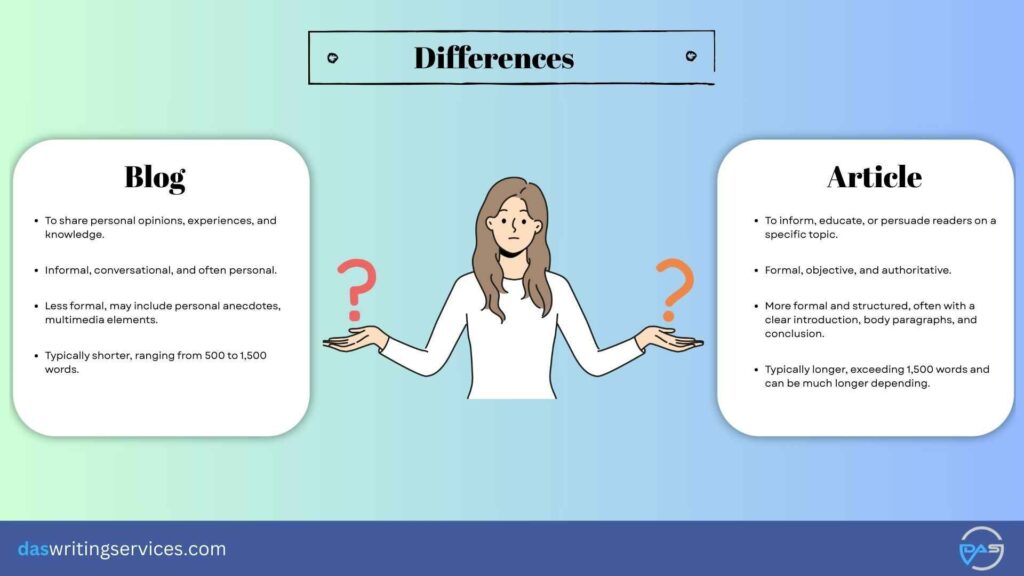Have you ever wondered what type of content can boost your brand awareness? While exploring various content writing topics, digital marketers are often confused about what to choose between a blog and an article.
Although the terms are sometimes interchangeable – a blog and an article differ. Both have unique structures, features, and guidelines that can impact your brand perception differently.
Let us explore the key differences between blog vs article that set them apart.
Why Do Digital Marketers Often Get Confused Between Blog vs Article?
The misunderstanding of the difference between blog and article writing happens to almost every single businessowner who is not in the relevant field. This made the task of digital marketers a bit difficult to create engaging content.
In earlier times, blogs included personal anecdotes that emphasized a conversational approach. This approach helped marketers to differentiate it from articles. However, the evolution of content marketing started to include analytical information.
In addition, you can find a blog and an article on the same website nowadays. You might face trouble differentiating the two formats because of these.
Blog vs Article: An Overview

Understanding the differences between blog writing vs article writing is crucial for digital marketers.
Determining whether an article format or a blog format aligns with your content marketing strategy is crucial while exploring different blog ideas for your business.
The table below highlights seven crucial aspects that set apart a blog and an article:
| Aspects | Blog | Article |
| Tonality | Casual or informal tone | Formal and Professional Tone |
| Length | Up to 1200 | Up to 5000 |
| Point of View | Emphasize the first and second person | Emphasize the third person |
| Target Audience | Readers who want to get quick and specific information | Readers who want comprehensive information |
| SEO | Particular set of keywords | Large number of keywords |
| Format | Does not have any particular structure | Structured format with large sections |
| Visual Elements | Focus on images, infographics, and videos | Focus on textual information |
What is a Blog?
The word ‘blog’ is a combination of web and log. This means that blogs are written content that is published online, especially on a company’s website.
There are different types of blogs. For instance, individuals write personal blogs to share their travel experiences or present opinions about a soccer match. Companies also upload informational blogs to improve their website’s Search Engine Optimization (SEO).
According to Hostinger’s research, almost 70% of online users prefer reading blogs to watching advertisements to learn about a company’s products or services. Simply because it tends to offer a more subjective, insight based take on topics instead of going completely promotional.
What is an Article?
Before highlighting the differences between blog vs article, you need to understand what is an article. An article is a type of written content that informs and entertains readers. Whether it be describing a current event or presenting a review of a movie.
You can find that articles are posted less than blog posts. Readers generally cannot comment or directly involve themselves with articles. Article writing avoids current events and considers attracting the general audience.
Articles use evidence to create an argument and conclude. Digital marketers using article writing put external opinions and quotes to make the argument evident, along with citing sources. You can find articles on websites, magazines, academic journals, as well as newspapers.
A Deep Dive into the 7 Key Differences of Blog vs Articles
Ultimately, recognising the fundamental difference between articles and blogs empowers you to take strategic decisions.
How?
Articles tend to highlight your knowledge and research skills. Comparatively, blogs can emphasize on your analytical insights and establish you as a thought leader in the industry.
So, you can choose between the two as per the effect you want on your target audience.

1. Tonality
The article vs blog confusion often revolves around the tonality. Blog writing requires a tonality that focuses on prioritizing a casual or conversational tone. Maintaining this tone in blogs makes the readers familiar with your perceptions and insights – fostering a deeper connection.
In a nutshell, you need to use a familiar tone in a blog to build a relationship with clients.
On the other hand, articles are often distinguished from blogs due to their formal and professional tone. Article writers should also emphasize well-researched data and different perspective to increase its depth of information.
2. Length
The word length matters a lot in choosing a blog or an article. It is widely accepted that a blog post is shorter than an article.
The length of blogs may differ greatly depending on the audience and topic. Including the short, medium, and long formats, a blog typically ranges from 300 to 1200 words.
An article with well-researched information and different opinions has a word count of up to 5000 words. When reading an article, readers want to receive directly relevant information.
3. Point of View
It is also important to focus on the point of view to understand the article writing vs blog writing comparison.
Blog posts are generally written in the first and second person, including I, we, and you. This creates a conversational tone for the readers and allows them to connect with the author’s perspective and experiences.
While writing an article, you need to focus on objectivity and present neutral opinions. Articles are written in the third person as they include facts and arguments.
4. Target Audience
The target audience is an essential aspect of differentiating blog vs article. Blog writers target and engage with a specific interest group or community. Blogs are relevant for time-conscious readers who want to grasp quick information from the internet.
For example, readers willing to cook a new dish should explore informational blogs related to food.
On the other hand, article writers should target a more dedicated audience willing to invest precious time to get comprehensive information on a topic.
For instance, individuals who want to stay updated with the recent advancements in medicine may opt to read authoritative articles related to medicine.
5. SEO
SEO is an important aspect that distinguishes a blog or an article. A blog focuses on a particular set of keywords. Using primary keywords and secondary keywords, a blog increases the visbility of a website via Search Engine Results Pages (SERP).
Conversely, an article incorporates a larger number and variety of keywords and internal links. It strives to establish topical authority and claim thought leadership in the industry.
6. Format
The format is a vital component in comparing a blog and an article.
Blog writers prioritize employing bullets, and subheads, and avoiding chunky paragraphs. A blog comes with a loose structure, and there is no specific rule on formatting, length, or sections. The layout and visuals in a blog are also flexible.
On the other hand, articles include a structured format, with large sections and subsections. An article maintains a strict format of introduction, body, and conclusion. Using a formal tone, article writing is all about having a clear purpose and flow.
7. Visual Elements
Incorporation of visual elements also differs between a blog and an article. Blogs often include videos, and images to keep readers engaged on a web page. These multimedia elements allow users to connect and understand the information.
An article includes infographics, namely: statistics, pie chats, bar graphs, representative images, and other visual elements. This helps the reader get visual cues and supplementary information that backs existing arguments.
As you are well aware of the key difference between blog vs article, now you must know how to write each of them and create engagement for your website.
How to Write a Blog for Creating Engagement?

Blogs make the task for digital marketers easier to promote their website on Google. As per the findings of Hostinger, firms that post blogs saw a 67% increase in monthly leads compared to those that do not post blogs.
Get ready to write a creative blog for user engagement with these simple steps:
1. Choosing the Right Topic
The first and foremost approach is to choose an engaging and relevant topic for your blog. You may also create a topic based on what you want to say.
For instance, you are running a digital marketing firm. You can write a blog on the upcoming trends of digital marketing or how to write a technical blog.
One of the best approaches to finding the right topic is using a keyword planner to find popular questions based on your industry.
2. Conducting Effective Research
Effective research not only helps to create engaging blog content but also boosts your ranking potential. You need to be clear about the reason behind choosing the topic and the need for this topic.
Research is crucial for ensuring accuracy, trust, and relevance to the target audience. With thorough research, you may provide valuable and updated information for readers. Identifying the needs of your audience is a great strategy for blog writing.
This can increase the trust of your users and your search engine ranking.
3. Start Your Writing – Boldly!
The final step is to write your blog. Start writing your blog with proper information distribution to give clarity to your readers.
Striking a balance between empathetic and emphatic is crucial for writing a blog. Additionally, you must ensure that your blog content is simple and easy to read. Make sure you are not showcasing your vocabulary range. Try to engage users by writing easy-to-understand words and avoiding complex jargon.
How To Write an Article for Creating Engagement?
Maintaining user engagement by writing an article is as easy as writing a blog. Follow these simple steps to write an article that can boost user engagement:
1. Understanding Your Audience
Understanding your audience is the primary objective of writing an engaging article. You must know the goals, need, and the pain points of readers before you write an article. This will help you to use the relevant and important information.
For instance, if you are a seller of electronic goods, you must write articles on the advancement of technology or robotics. You should make your readers interested so that they become curious about your services.
2. Create a Hook
Now you must create a hook for your readers with an engaging introduction. Here you can ask a question, use an anecdote, a stat, or a quote. It allows the readers to invest their precious time in reading your article.
Using powerful words or humor can also hook the readers and capture their attention. Case studies can also be an effective content strategy to enhance engagement.
3. Create Multiple Subheads
The third step is to create multiple subheads for your article . The process of outlining your blog helps to organize the information that you want to present. This not only gives you a clear idea of topics but also improves the reading experience.
In addition, creating multiple subheadings with specific keywords can also improve your SEO performance. Below are the things that you must consider while creating an outline:
- What is the goal of your article?
- What do you want to present?
- How many paragraphs are good for your article?
- What are the images or infographics that support your viewpoints?
4. Start Your Writing
The third step is to start your writing. Writing an article will be a bit more informative and objective than writing a blog.
For example, the chosen topic for your article is ‘How to create engaging content?’. You need to use the resources from the internet that hold high standards and quality information. Enter valuable information as much as you can that meets user expectations and aligns with your brand voice.
You must thoroughly verify your information and cross-check the overall article after finishing it.
5. Incorporate a Call-to-Action
The final step of article writing is to incorporate a call-to-action. Including a call-to-action is a proven approach to lead people to commercial search intent pages.
It tempts readers by asking them to take action, like visiting one of your product pages or following your business via multiple platforms.
Takeaway
Being aware of the difference between blogs vs articles, or what sets them apart, is important for businesses to engage more audience. However, you must know both approaches to making unique content.
Striking the perfect balance between quality and quantity, your digital marketing team can create a successful content strategy that can engage more users, which ultimately increases your sales conversion.
Frequently Asked Questions on Blogs vs Articles
1. What is the difference between a blog and an article?
The primary difference between a blog and an article is that a blog is written in a conversational tone, and an article is written using a formal tone. In addition, blogs contain more infographics while articles prioritize more textual information.
2. Can a blog post be called an article?
Although they are different, blogs can be called articles in particular circumstances. Some blogs include a detailed analysis, which can assume a moderate position between an article and a traditional blog.
3. How to identify a blog or an article?
To identify written content as a blog or an article, first, you need to consider the tone of writing. A blog contains a conversational tone, while an article is written in a formal tone. Then identify the length and format of the content.
Subhodip Das is the founder and CEO of Das Writing Services Pvt. Ltd. He has an experience of 12 years in the field of Digital Marketing and specialises in Content Writing and Marketing Strategies. He has worked with well-established organisations and startups helping them achieve increased Search Engine Rank visibility. If you want to grow your business online, you can reach out to him here.




Leave a comment